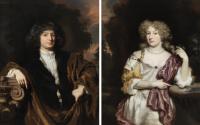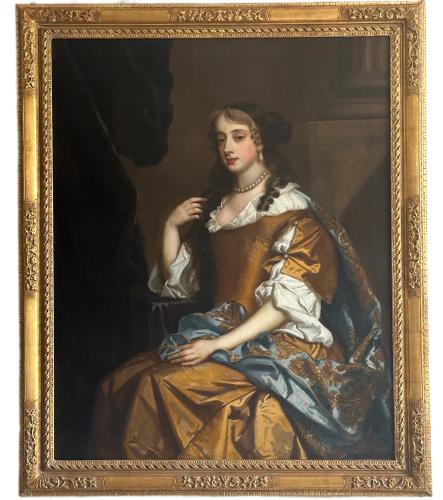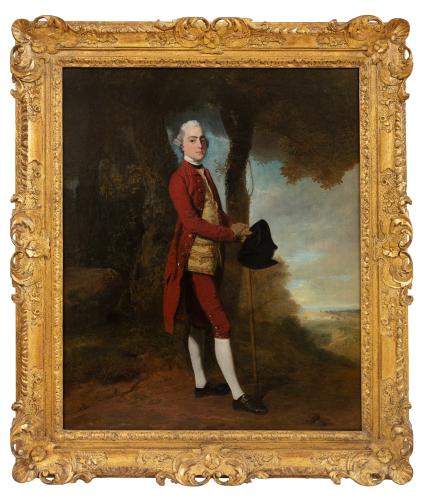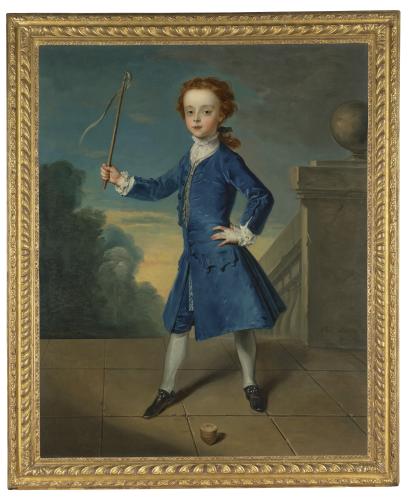




Price
£40000.00This object includes complimentary, Insured Shipping / Delivery within the UK
This object includes complimentary, International Insured Shipping
This object is eligible for a Certificate of BADA Provenance
The BADA Standard
- Since 1918, BADA has been the leading association for the antiques and fine art trade
- Members are elected for their knowledge, integrity and quality of stock
- Our clients are protected by BADA’s code of conduct
- Our dealers’ membership is reviewed and renewed annually
- Bada.org is a non-profit site: clients deal directly with members and they pay no hidden fees
A rare pair of three-quarter length 'marriage' portraits by one of the foremost dutch portrait painters of the 17th century, Nicolaes Maes (Dordrecht 1634-1693 Amsterdam). The gentleman signed lower left 'Maes 1679'. Oil on canvas in dutch style ebonised frames. Dimensions 58 x 47.5cms each.
The gentleman is shown in a landscape at dusk, leaning against a stone capital, wearing a white chemise decorated with lace, a black coat and a brown silk cloak draped across his body.
The lady is elegantly dressed in an ivory silk gown decorated with jewels on the neckline and shoulders, the contrasting sleeves in gold fabric, with a rose pink silk cloak draped over her shoulder and bodice. She wears a pearl necklace and earrings with her fair hair worn up with ringlets falling down onto her chest in the fashionable style of the day. She stands with one hand touching a lock of her hair as she rests her arm on the bowl of a stone water drinking fountain.
Although the identity of the sitters has been lost over time, as they were painted after Maes had settled in Amsterdam in 1674, they are likely to have been wealthy Amsterdam burghers (citizens), seeking to show their prosperity and high social status by being painted by one of the most highly sought after and celebrated artists of the day.
Provenance: Private collection, Belgium
Nicolaes Maes was one of Rembrandt's most talented pupils. As a boy of about thirteen or fourteen, he left his parents' home in Dordrecht to serve his apprenticeship with the master in Amsterdam. He spent four or five years in Rembrandt's workshop, returning to Dordrecht in 1653 as a fully-fledged artist. Maes started out as a ‘history’ painter, following in Rembrandt's footsteps, but he soon switched the focus of his activities to genre painting of intimate and detailed domestic scenes. In a short period between 1654 and 1658 he was one of the most innovative painters in this field. His skill at representing an interior as a suite of rooms rather than a three-wall, one-room enclosure, and the true-to life details and intimate nature of his paintings had great impact on the Delft painters Johannes Vermeer and Pieter de Hooch.
In the 1660s, however, Maes began to turn more to portraiture, and after a visit to Antwerp around the middle of the decade his style changed dramatically. He abandoned the reddish tone of his earlier manner for a wider, lighter and cooler colour palette, and the fashionable portraits he now specialised in were closer to those of Van Dyck than to Rembrandt.
Arnold Houbraken's 1721 biography described the transformation: Maes "learned the art of painting from Rembrandt but lost that way of painting early, particularly when he took up portraiture and discovered that young ladies preferred white to brown."
Maes painted his first portraits in 1655, and shortly before 1660 he stopped painting genre works and other paintings altogether, concentrating solely on portraiture, eventually developing a colourful and elegant style that appealed to a broad circle of wealthy clients in Dordrecht, Amsterdam and beyond.
Dimensions
58 x 47.5cmPrice
£40000.00This object includes complimentary, Insured Shipping / Delivery within the UK
This object includes complimentary, International Insured Shipping
This object is eligible for a Certificate of BADA Provenance
The BADA Standard
- Since 1918, BADA has been the leading association for the antiques and fine art trade
- Members are elected for their knowledge, integrity and quality of stock
- Our clients are protected by BADA’s code of conduct
- Our dealers’ membership is reviewed and renewed annually
- Bada.org is a non-profit site: clients deal directly with members and they pay no hidden fees








